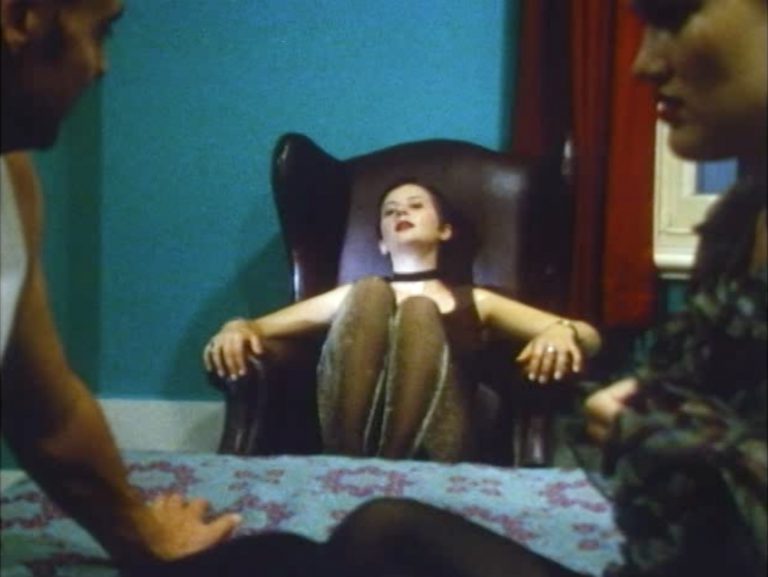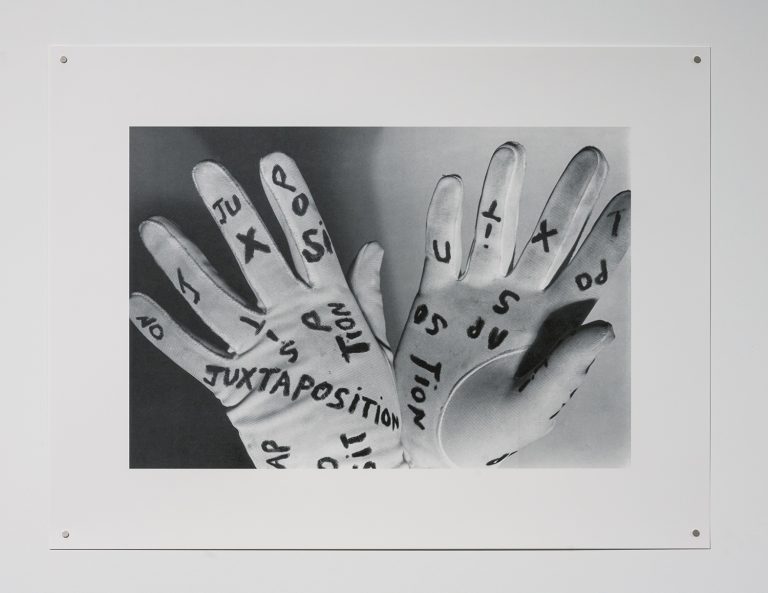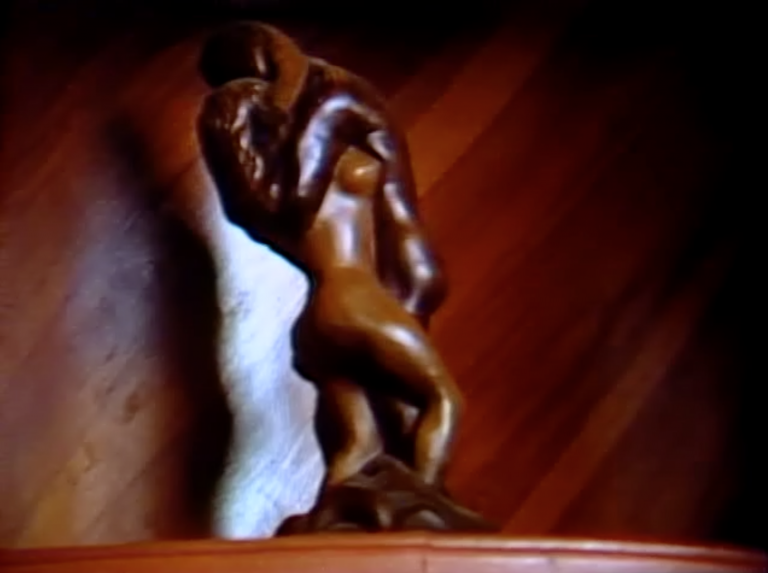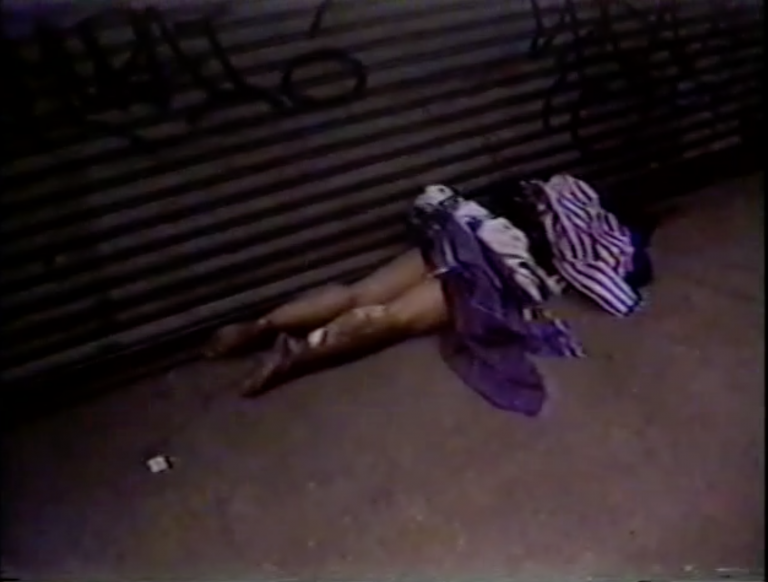Chris Kraus made nine films between 1982 and 1995, each of which is on display at her solo exhibition, In Order to Pass at Chateau Shatto in downtown LA. Most are familiar with Kraus as the creator of I Love Dick, her feminist (?) epistolary novel about female desire and obsession, both of which are at play in her film exhibition. Much like Kraus’ books, which span fiction, cultural criticism, and art theory, none of Kraus’ films are firmly situated in any particular genre, or even descriptor. They aren’t fully narrative, documentary, or conceptual films, but instead create a kaleidoscope of stories, political issues, and literary and cultural references.

In Aliens and Anorexia, Kraus’ novel that makes the most suitable companion to the show, Kraus tells the story of making “Gravity and Grace,” her only feature-length film, named after a posthumously published compilation of texts by the French Christian mystic philosopher Simone Weil. The film follows two young women, Gravity and Grace, through their time in a religious cult in New Zealand. Grace becomes disillusioned and moves to New York to try out the art world, only to become more disillusioned and fail as an artist. She has a meeting with a New Museum curator, played by Kraus herself, who spews bombastic critique — “The sublime has always been on the side of shit. Face it, Gravity, your work just isn’t shitty enough. It’s illustrative of the peripheral conditions of shit.” The viewer might feel uncertain about the true subject of the curator’s appraisal.

Gravity and Grace
Aliens and Anorexia is largely about the fact that Kraus believes “Gravity and Grace” to have been an artistic failure, and that this failure provides the context for her penetrating, self-deprecating voice as a writer. “‘Gravity and Grace’ was just so unappealing,” she writes in the novel, “It was an amateur intellectual’s home-video expanded to bulimic lengths.” Kraus was similarly critical of another of her film exhibitions at Real Fine Arts in Brooklyn in 2011, about which she wrote, “These films have nothing to do with me now. Their exhibition comes too late to feel like a vindication. Nevertheless it’s a pleasure — an abstract affirmation of a practice I’m no longer involved in but will never recant.”
Why show a film that the artist herself considers a failure? Taking pride in failure or slobbishness — artistically or socially – is so often a thinly veiled attempt to shield oneself from criticism. But in the show, as with her novels, Kraus uses failure as a narrative starting point, then dramatizes it. To focus intently on the quality of the individual films, or the fact that they have been long-overlooked by curators and critics, would be to risk missing this crucial success of the exhibition. By creating a show of failed works about failure, Kraus creates a space to challenge the success-failure binary and examine her own subjectivity over her career.
To do so requires a certain decreation of self, which is perhaps the most compelling component of In Order to Pass. On Simone Weil, who embodied a philosophy of self-denial, Kraus wrote, “She wants to lose herself in order to be larger than herself. A rhapsody of longing overtakes her. She wants to really see. Therefore, she’s a masochist.” This notion of the desire to see as a form of masochism is potent throughout the exhibition, because to Kraus, to see the world often means to find ugly, unpleasant realities like failure.
The films largely feature wounded protagonists resigned to disgrace. In “How to Shoot a Crime,” 1987, filmed with her then-husband Sylvere Lotringer, Kraus visits gruesome homicide scenes. In “Foolproof Illusion,” Kraus builds a snowman in her underwear, complaining about a violent husband and reading the work of Antonin Artaud, the French playwright known for developing the Theatre of Cruelty. In “Traveling Light,” she joins a class of schoolchildren to learn about the history of the Underground Railroad. In Terrorists in Love,” a woman reads a manifesto in a bar: “We are minor members of the Paris Semio-Kinetic Post-Surrealist School, North American branch,” satirizing the art-theory world in which Kraus is active. The films are strongest when they exhibit Kraus’ trademark sardonic self-awareness.
Kraus describes the impulse to make the films as “A terrible megalomania, an insistence on being present – even when one has no personal presence – through one’s double, the film… Much as I loathe the idea of a feminine ecriture, I have to admit that the impulse to do this seems very female. Barbara Rubin is a patron saint of this kind of film … 15-year-old girl given a Bolex transforms her isolate misery into Christmas on Earth.” Though filmmaking does not reflect phenomenological reality, Kraus is onto something with the assertion that there is something feminine about her work and the canon that informs it.
Angry woman, artist, writer: Kraus’ acts of identity — the one who creates in response to patriarchal forces, the one who then writes about what she created — all relate to a more fundamental action of performative gesture. Above all, Kraus encourages us to read theory, including her own, as this kind of gesture as opposed to sermonic truth. To read her books or see her films is to be challenged to reject an antiseptic, clinically evaluative way of looking at art in favor of a more fluid, embodied criticism. The result with In Order to Pass is a robust interaction between the body of work and the artist that produced it.
Chris Kraus’ In Order to Pass: Films from 1982-1995 runs through June 23 at Chateau Shatto. One might want to plan multiple visits, as the footage totals over three and a half hours.





